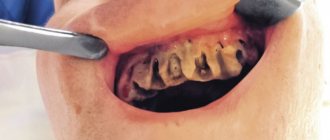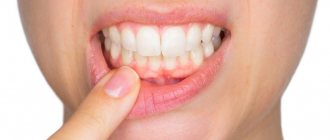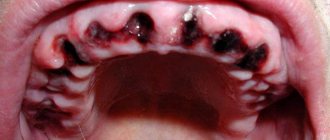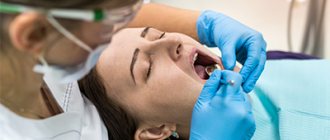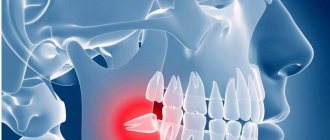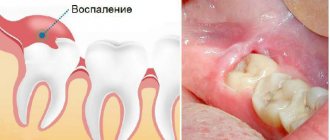Why are sutures required after wisdom tooth removal?
Extraction of the third molar requires suturing. It is not always possible to save the patient from the procedure described above. Even when working with high-quality equipment, a competent dentist will encounter problems. The third molar is secured with the help of two roots, the removal of which requires making a few incisions, and then removing the tooth body from the gum. Sutures are also applied if there are clinical signs of gum inflammation. Swelling is considered a natural process for the body, due to damage to the gums during incisions. The suturing procedure is also a preventive measure, which reduces the risk of infectious pathological syndrome; pathogenic bacteria do not penetrate into the open wound. The smaller the size of the wound, the lower the likelihood of infection, the age the rate of regeneration. Regardless of the type of thread used, suturing takes a short period of time. Self-absorbable threads are a more preferable option; they do not need to be removed and re-injure the gums.
Patient's fears
The reason for a person’s patience and postponing the procedure for later is stories from acquaintances and friends about pain and frightening reviews on social networks and forums.
When pain occurs as described by those being treated:
- during surgery - common when a tooth is removed from the lower row and is associated with the structure of the jaw. The dental surgeon needs to use a thin needle of a syringe with an anesthetic to hit the jaw nerve located in the gum; therefore, when the doctor is inexperienced or in a hurry, he does not hit this point, and therefore does not freeze; Also, the reason for the lack of pain relief may be diffuse inflammation, which also reduces the effect of freezing.
- after the procedure - is associated with interference in the body, especially typical for complex removal, which is associated with strong interference in the tissue, and can also cause the development of inflammation of the socket after the removal of a wisdom tooth.
While taking it, listen carefully to your feelings. If you don't feel enough numbness in your tongue and gums, ask for an extra shot to avoid a traumatic experience.
Important! Find out in advance what type of anesthetics are used in the clinic. Paid institutions use derivatives of articaine. Lidocaine has proven to be less effective in these cases.
For competent removal of wisdom teeth without pain, the manual skill and experience of the doctor is important. Correct use of anesthesia will avoid pain, and following the doctor’s recommendations after surgery will protect you from inflammation and swelling.
Aware means armed
Even if you consult an experienced doctor and follow all the advice, side effects may occur in the first days or weeks of removal.
Swelling after wisdom tooth removal is associated with inflammation of the place where the tooth was recently located. If there is bad breath, pain when cold or hot gets on the wound, and there is no special clot that protects against food, then infection is possible. See your doctor.
Numbness of the lower lip - occurs when working on the lower jaw, when the position of the tooth is too close to the mandibular nerve.
Bleeding is common in the patient's chair, but spontaneous bleeding may occur in the following cases:
- apply a swab or rolled cotton wool to the hole and bite down forcefully to compress the wound;
- use ice packs on the cheek;
- take blood pressure medications if necessary
Types of deletion
The division is quite simple: the bottom row, twisted, twisted roots bring more problems, while the bone is dense and uniform.
Simple
Characteristic for the correct positioning of the tooth and easy accessibility of the working area. In this case, after anesthesia, the dental surgeon uses an instrument resembling a scalpel to separate the mucous membrane from the dental tissue, and then begins to loosen it using forceps.
For the top row, an elevator is used - with the help of which it is removed from the hole. The mobile root is then removed with forceps.
The process takes 10 minutes, including suturing.
Complex
Suitable for unerupted lower teeth with branched, crooked roots, severe tilting or curvature, or complete destruction of the upper part of the tooth.
In this case, it is not possible to use forceps for grasping, and the actions are as follows:
- cutting the gums - first, as in a simple removal, the mucous membranes are pulled apart in order to see the roots of the tooth and the bone around it;
- sawing the tooth into pieces with a drill;
- extraction of each root separately using an elevator.
Note! At this stage, the bone under the teeth is drilled to increase loosening and speed up extraction from the jaw.
After the operation, the wound is sutured. Whether to remove the stitches or whether they will dissolve on their own in 7-10 days depends on the clinic and specialist.
For complex manipulations, a preliminary full diagnosis with an X-ray or volumetric 3D computer image is required to develop a removal strategy. With the correct preparatory stage, after the removal of a wisdom tooth, the socket, gums and cheek do not hurt.
Diagnostics makes it easier
A comprehensive consultation is first required, which consists of several stages:
- Anamnesis collection - information about allergies to medications, chronic diseases (diabetes, asthma, blood pressure surges, clotting problems). At the same time, the patient’s data is not personal speculation; it is necessary to donate blood for indicators of interest and, if possible, take extracts from the cards;
On a note! Many drink aspirin uncontrollably, which thins the blood and leads to the development of severe hematomas during intervention, so it is necessary to notify the doctor. Women need to be told about the day of the menstrual cycle, since platelet counts in the first days decrease by 40% and contribute to difficulties in stopping bleeding.
2. After the tooth is removed, the dentist will carefully check whether there are any dental remains left, and if necessary, apply a drug into the socket that will reduce the risk of inflammation and swelling after the removal of the wisdom tooth;
3. Applying sutures even with simple removal is not a classic wound removal, but bringing tissues closer together so that food debris does not fall into the hole, preserving the clot and reducing inflammatory processes by 80%. Some people use self-absorbing sutures, so you don’t have to visit the dentist additionally. Spare no expense, it will save nerves and speed up recovery.
How to understand that complications have arisen after suturing?
Alarming symptoms after removing the “eight” are as follows:
- heavy bleeding that lasts more than a day;
- severe pain, throbbing pain that prevents you from sleeping or leading a normal life;
- very large swelling;
- redness in the intervention area;
- blood in saliva in the first three days after the intervention;
- elevated body temperature.
In all these cases, you must consult your doctor. It is possible that stitches will have to be stitched again to avoid complications.
Pain after suturing the hole: pathology and norm
Pain in the suture area is normal. Injury to the gums due to major surgery causes pain, especially in the first days.
The patient must understand that tooth extraction means damage to the ligaments that hold the tooth in the gum, rupture of nerve fibers and blood vessels. During the operation, the pain is blocked by the anesthetic, but after the anesthesia wears off, discomfort is observed at the site of the sutures.
The following sensations should not cause concern:
- aching pain for the first 24 hours after removal;
- slight swelling of the tissues in the surgical area
- discomfort and slight pain when opening the mouth;
- short-term increase in body temperature.
In rare cases, after a complex removal, the patient may experience chills, facial swelling, purulent discharge, cough, and nausea. These signs should not be ignored - it is better to immediately seek help from a specialist.
Useful tips for oral care
- hold the cotton swab applied by the doctor for 20-30 minutes;
- within 2-3 hours after surgery, be sure to apply cold compresses to reduce tissue swelling;
- carry out oral baths (not to be confused with rinsing) with antiseptic drugs for 3-5 days: “Miramistin”, “Chlorhexidine 0.5%” or other drugs prescribed by a doctor can be used as medicinal solutions;
- after 3-5 days, start using a toothbrush - only a soft one for the operated area, as well as a new one, without bacteria on it. The teeth of the opposite jaw can be brushed immediately, the main thing is to avoid the area of the extracted tooth;
- chew food on the side opposite the injured area;
- You can drink water immediately, preferably warm;
- You can eat only after the anesthesia wears off, that is, after 2-3 hours;
- Lead a quiet lifestyle, try to avoid physical activity and heavy lifting for 5-7 days.
Types of suture materials in surgical dentistry
In dental clinics, different types of threads are used to fix the edges of the sockets during tooth extraction:
- Synthetic, self-resorbable due to hydrolysis reaction. These are threads with a hypoallergenic composition that guarantee reliable fixation of the wound edges for about a month.
- Natural, absorbable, enzyme-based surgical suture material. The stitches disappear in 10-100 days, and the thread segments are safely removed from the human body.
- Synthetic regular threads. Made from silk, nylon, polyester. They require mechanical removal after complete healing of the hole.
What not to do after suturing.
- don't rinse your mouth! Mouth baths in the first 3-5 days are more than enough;
- do not use hot compresses! This is fraught with the appearance of edema and the development of inflammation;
- do not create a vacuum in your mouth: do not puff out your cheeks, sneeze, blow your nose and spit very carefully;
- do not pick the wound, do not touch the clot with your tongue;
- do not drink or eat hot or cold food, only warm food;
- try to quit smoking for at least 2-3 days after surgery;
- Do not drink alcohol for 2-3 days - it does not promote tissue repair. Also rule it out if your doctor has prescribed a course of antibiotics;
- Do not overcool or overheat - give up sports exercises, swimming pools, saunas for 5-7 days.
How long do you need to walk with stitches?
The patient's actions depend on the type of suture material used by the doctor. If the doctor used a non-absorbable option, a control appointment is scheduled after 7-10 days. During the examination, the surgeon assesses the speed of healing and the condition of the wound. Decides on the need to remove sutures.
The procedure is quick and atraumatic. The thread is cut into small segments and painlessly removed from the gums. If the patient experiences discomfort and anxiety, the doctor can use topical anesthesia.
Self-absorbing sutures disintegrate on their own in about three weeks. The patient may not notice the material disappearing from the wound. Especially if healing is going well and the hole is not bothering you.
Indications for the procedure
Removing the remaining tooth from the alveolar socket is a surgical procedure that affects the tissue around the root part. The decision to apply suture material is determined by the doctor’s intention to prevent infection from entering the wound - according to statistics, suturing the hole reduces the likelihood of infection by 98%.
The residual that forms in the gum structure after extraction is a blood clot, which acts as a protective barrier to protect the socket from bacteria. Applying sutures eliminates the possibility of its displacement, preserving the area from the negative influence of the pathogenic environment. Suturing reduces the risk of the formation of inflammatory processes, as well as purulent areas that arise due to food particles stuck inside the wound cavity. In addition, the procedure is recommended at the first symptoms of edema formation, and promotes accelerated healing and fusion of wound edges.
Clinical indications considered as a basis for the procedure include the following situations:
- Extraction of wisdom teeth, accompanied by profuse bleeding that persists for several hours after the operation;
- The absence of a blood clot acting as a barrier to potential infection;
- Removal of completely destroyed elements, as well as impacted or dystopic units of the dentition.
The decision to apply sutures and suturing the alveolar socket is made based on the clinical picture observed in the postoperative period.
What types of sutures are distinguished in dental implantology?
Sutures after bone grafting and sinus lifting are usually used of 3 types:
- Monotypic or single;
- Supporters;
- Continuous.
Single sutures are not recommended if the lingual and vestibular flaps are located at different levels. The thread ends are tied so that the knot is located close to the buccal surface of the alveolar process. As a result, this makes it easier to remove sutures in the future and is a preventive method for possible tongue injuries. Especially for those threads that have hard and traumatic ends.
A supporting suture is used in cases where there is a limitation for surgical intervention, and cutting occurs exclusively on the vestibular or lingual flap.
A continuous suture is used in the area of several teeth, when all the flaps must move in the apical direction. As a result, the cheek flap is fixed along its entire length. From the inner edge, the entire procedure is repeated, but with a lingual flap. The knot is tied in the same place where the seam was originally.
Briefly about the introduction of dental implants
To install a metal structure into the bone tissue, it is necessary to make an incision in the mucous membrane. At the end of the surgical intervention, suturing is required. If the outcome of the operation is favorable and there are no consequences, the surgical threads are removed after about 10 days.
The operation process itself is completely painless for the patient, this is thanks to high-quality anesthetic drugs. A little pain is possible only during the rehabilitation period. If you follow all the doctor’s recommendations, all troubles can be avoided, however, not always everything depends only on the patient’s behavior.
We answer frequently asked questions from patients -
If you have a wisdom tooth removed: what to do after removal, what to rinse with, how quickly the hole will heal and when it will be possible to treat your teeth... We answer all questions separately.
How to rinse your mouth after wisdom tooth removal -
It is best to rinse your mouth after wisdom tooth removal with the antiseptic Chlorhexidine. This drug is sold in every pharmacy and costs only about 30 rubles per 100 ml bottle. Please note that you can only rinse your mouth slowly, because... Strong rinsing can cause a blood clot to fall out of the socket of the extracted tooth. The latter will lead to the development of inflammation.
How long does it take for gums to heal after wisdom tooth removal?
How long it takes for the gums to heal after wisdom tooth removal depends on the complexity of the removal. Typically, you must wait 1 week to begin treatment after wisdom tooth removal. But after a complex removal, the gums may take longer to heal (up to 10-14 days), which will depend on the degree of traumatic removal. If inflammation occurs in the hole, healing may take 20-30 days. We hope that our article on the topic: Wisdom tooth removal, how much it hurts, turned out to be useful to you!
Sources:
1. Dental education of the author of the article, 2. Based on personal experience as a dental surgeon, 3. National Library of Medicine (USA), 4. “Pathology of wisdom teeth eruption” (Rudenko A.), 5. “Qualified removal of third molars” (Asanami S.).


